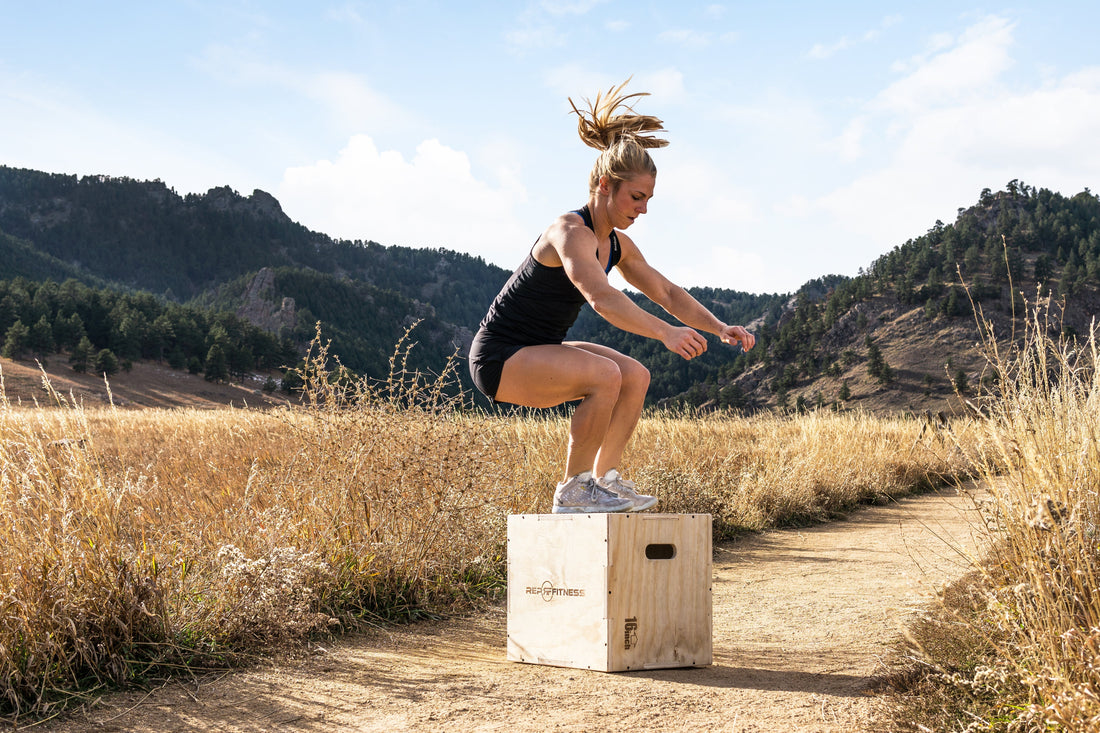
There are so many reasons to add a plyo box to your home or commercial gym – and there are also various kinds of plyo boxes.
A soft plyo box is always a solid choice, because its outer foam cover absorbs impact if you slip and miss your jump. And the grippy vinyl is textured to reduce slipping and keep the box in position on the floor.

12 different ways to use a plyo box
Mix and match these plyometric exercise ideas as best fits in with your workout at home protocol.
Day 1: Speed, power, strength, endurance, stamina, and coordination

Box jumps check all of these boxes. This is the most quintessential plyo box exercise – but while it’s well-known, it’s not always that easy. Here’s a guide to help you improve your box jumps (and get over the fear. Spoiler alert: That soft jump box is going to be your BFF).
Day 2: Glutes and legs
Box squats can also be performed on a plyometric box. You can use a barbell, bodyweight, or dumbbells to squat down to the box, pause, and drive back up.
Day 3: Chest
Switch out your regular bench for a box bench press on a plyo box (harder/wood is best, but you can do this on a soft box, too) to mimic some of the same benefits of a floor press – but with leg drive. Try it and see.
Day 4: Core
Do V-ups sitting on your plyo box instead of a bench. Sit on the box, hold onto the edge of the box, extend your legs, and lean back (farther is harder). Keep your legs straight and knees together. Bring your knees or legs to your chest, making a “V” shape with your body. Inhale as you extend the legs back out, and exhale and you pull them in.
Day 5: Triceps/shoulders

Use a plyo box in the same way you’d use a bench for triceps dips. Sit at the edge of the box with your hands on the edge next to you and your knees at 90 degrees/feet on the floor. Bend your elbows and shoulders, slowly lowering your body, until your forearms are at 90 degrees. Make sure you lock your shoulder blades back and down.
Day 6: Quads and hams

Bulgarian split squats are everyone’s favorite leg torture. In a lunge position, elevate one leg on the box and lunge in place, focusing on working the standing leg. Move your standing leg in closer so your knee goes farther over your foot while you’re standing more upright to target the quads. Move that leg farther away and drive back/less upright to feel the burn more in your hamstrings.
Day 7: Chest/shoulders

There are many ways to do push-ups on a plyo box. Modify your push-ups and add different challenges by elevating your feet or hands on the box to make incline or decline push-ups. Incline (hands on the box) are going to be an easier modification, and decline (feet on the box, hands on the floor) will add more upper chest/shoulders and is harder than a normal push-up.
Day 8: Glutes and legs

Step-ups are low impact but highly effective. Work your legs by stepping up and down off the box, either with or without weights.
Day 9: Full body
Burpee box jumps will target your whole body and also work your explosive power. Do a burpee in front of your plyo box, and when you land on your feet, jump up on top of the box.
Day 10: Calves
Stand on the edge of the box with the balls of your feet on the box and your heels off. Raise and lower your body using your calves. You may want to do this next to your power rack for balance. You can also add weight to make it harder.
Day 11: Glutes
Perform hip thrusts with your shoulders resting on the plyo box instead of a bench. You can make this harder with a barbell or by holding a dumbbell at your hips.
Day 12: Full body
Try decline mountain climbers with your feet on the box and your arms on the floor. This low-impact exercise is tough on the core, but it also challenges your legs, shoulders, glutes, lower back, arms, balance, coordination, and cardiovascular system.
OTHER EXERCISES TO TRY ON A PLYO BOX

- Lateral step-ups
- Single-leg box squats
- Pistol squats
- Side planks
- Box jump overs
- Single-leg jumps
Aimee Heckel, CPT, is a health and fitness journalist with over 20 years of experience. She set an all-time world-record deadlift in her division across all powerlifting federations at Mr. Olympia. In addition, she earned a national deadlift record and 18 Colorado state records. Heckel also has nine world records in grip sport, a pro card in natural figure bodybuilding, four first-place bodybuilding titles, and was named IPE Ms. Colorado Figure.

NEWSLETTER SIGNUP
Product launch information, promotions, blogs, and REP news.







